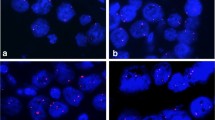Abstract
Nuclear extract and image cytometry was used to determine the DNA ploidy pattern of 31 pure seminomas. At least 5-year but usually 10-year follow-up was available to compare the clinical outcome to the DNA ploidy pattern. In 24 cases (77.4%) the DNA indexes (DI) showed tetraploid (1,8 < DI > 2,2) pattern confirming the recent cytogenetic and flow cytometric DNA studies of others. However, in 7 cases (22,6%) the tumors were aneuploid. Out of these aneuploid cases 2 had two subpopulations and 2 had less than 1,8 DI. These latter cases (providing the loss of chromosomal DNA) had elevated AFP levels in serum that raises the question of nonseminomatous transformation without any morphological evidence. Usually, the aneuploid cases had worse prognoses but there was no significant difference. Because of the small number of aneuploid cases wider clinicopathologic studies are required to confirm our results.
Similar content being viewed by others

References
Atkin NB and Baker MC: i(12p): specific chromosomal marker in seminoma and malignant teratoma of the testis? Cancer Genet Cytogenet 10:199–204, 1983.
Bosl GJ, Demitrovsky E, Reuter VE, Samaniego F, Rodriguez E, Geller NL and Chaganti RSK: Isochromosome 12: clinically useful marker for male germ cell tumors. J Natl Cancer Inst 81:1874–1878, 1989.
Carey F: Measurement of nuclear DNA content in histological and cytological specimens: principles and applications. J Pathol 172:307–312, 1994.
El-Naggar AK, Ro JY, McLemore D, Ayala AG and Batsakis JG: DNA ploidy in testicular germ cell neoplasms: histogenetic and clinical implications. Am J Surg Pathol 16:611–618, 1992.
Ewing J: Teratoma testis and its derivates. Surg Gynecol Obstet 12:230–261, 1911.
Fossa SD, Nesland JM, Petlersen EO, Amellen O, Waehre H and Heimdal K: DNA ploidy in primary testicular cancer. Br J Cancer 1991:64:948–52.
Friedman NB: The comparative morphogenesis of extragenital and gonadal teratoid tumors. Cancer 4:265–276, 1951.
Hedley DW, Friedlander ML and Taylor IW: Method for analysis of cellular DNA content of paraffin-embedded pathological material using flow cytometry. J Histochem Cytochem 31:1333–1335, 1983.
Marks LB, Rutgers JL and Shipley WU: Testicular seminoma: clinical and pathological features that may predict para-aortic lymph node metastases. J Urol 143:524–527, 1990.
Oliver RT: Limitations to the use of surveillance as an option in the management of stage I seminoma. Int J Androl 10:263–268, 1987.
Oosterhuis JW, Castedo SMMJ, de Jong B, Cornelisse CJ, Dam A, Sleijfer DT and Koops HS: Ploidy of primary germ cell tumors of the testis. Pathogenetic and clinical relevance. Lab Invest 60: 14–21, 1989.
Ro JY, Dexeus FH, El-Naggar AK and Ayala AG: Testicular germ cell tumors: clinically relevant pathologic findings. Path Ann 28:58–87, 1991.
Sternberg SS: Diagnostic surgical pathology. Second Edition, Raven Press, New York, 1994.
Author information
Authors and Affiliations
Rights and permissions
About this article
Cite this article
Sápi, Z., Szapanidisz, J., Tóth, B. et al. DNA ploidy pattern in pure seminomas. Pathol. Oncol. Res. 1, 71–74 (1995). https://doi.org/10.1007/BF02893587
Received:
Accepted:
Issue Date:
DOI: https://doi.org/10.1007/BF02893587



